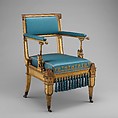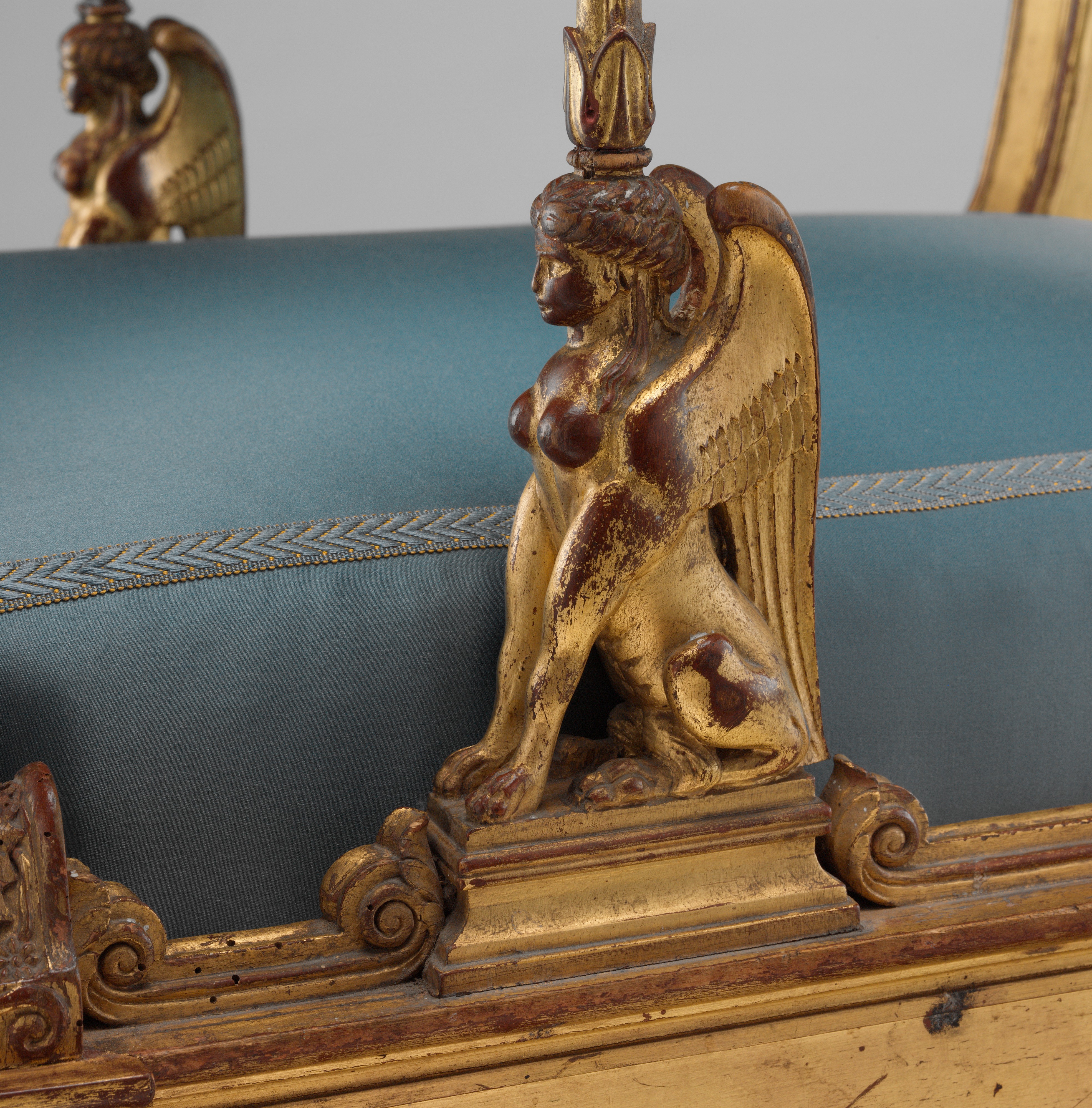Armchair
Designer Karl Friedrich Schinkel German
Possibly made by Johann Christian Sewining
Possibly made by Karl Wanschaff German
Between 1826 and 1828, at the height of his influence as Germany's leading architect and most sought-after designer, Karl Friedrich Schinkel was commissioned by Prince Karl of Prussia (1801-1883) to remodel the prince's Berlin palace (destroyed in World War II). It seemed appropriate that Karl, a son of King Frederick William III of Prussia (1770–1840) and the younger brother of King Frederick William IV (1795–1861) and Emperor William I (1797–1888), would engage the court architect Schinkel to draw up the plans. For the Marble Hall (or Reception Hall) Schinkel designed a luxurious suite of gilded furniture, comprising two sofas and eight armchairs, one of which is the present piece.[1] Many of the details reflect the designer's sensitivity to all aspects of the room's decor. One of the most intriguing of these is the similarity between the sides of the sofas and the pattern of the inlaid border of the wooden floor.[2] Like most display furniture, all ten pieces would have been placed against a wall. The details of the show covers and the ornaments on the front, such as the sphinxes looking forward from the arm supports and the lion mascarons on the armrests, give the furniture a ponderous grandeur; however, the chairs, which are indeed extremely heavy, have casters and can be moved-belying their monumentality and very much to the astonishment of the viewer, who can thus appreciate them from all sides.
Until recently there was much confusion as to how many examples of the chairs of the former suite were still in existence.[3] The situation is now thought to be as follows. The Stiftung Preussische Schlösser und Gärten Berlin-Brandenburg currently displays two chairs in the Schinkel Pavilion at Schloss Charlottenberg, Berlin,[4] and there is a further example in storage at Schloss Charlottenburg.[5] The Kunstgewerbemuseum in Berlin owns two chairs, and there is another example, which has possibly retained much of its original upholstery under a later show cover, in the Danske Kunstindustrimuseum in Copenhagen.[6] Therefore, it seems that seven chairs (including the Museum's piece) have survived, leaving one example as well as the pair of sofas unaccounted for.
It is generally acknowledged that the Museum's chair is the prototype for the series and was made under the architect's supervision.[7] It retains most of its original gilding and the original casters, and, in addition, the decorative parts, such as the fully three-dimensional sphinxes and the flat relief ornamentation, are carved in wood following traditional chairmaking techniques. Molds were later made of these elements in lead, zinc, iron, and composite mass in order that casts might be applied to the other pieces in the suite.[8] As the chair prototype was one of the most expensive ever produced,[9] this was clearly done in order to simplify production and reduce costs. The use of different materials for the decorative parts of the later chairs reflects Schinkel's passion for exploring new production methods.
Schinkel's design for the prototype is based on an ancient Roman chair depicted in wall paintings that had been excavated in Herculaneum in the eighteenth century.[10] The sketch of a related but bolder chair in the Egyptian taste appears in plate 29 of Charles Percier and Pierre-François-Léonard Fontaine's Recueil de décorations intérieures, of 1801.[11] A closer comparison, however, is provided by plate 59, fig. 1, in Thomas Hope's Household Furniture and Interior Decoration, of 1807, a publication well known to the German architect. Hope's and Schinkel's interpretations clearly follow the ancient paintings, even to the extravagantly conceived but structurally weak armrests. If Schinkel's chairs are picked up by the arms rather than moved on their casters, the thin armrests and their fragile supports may break. A regilding of the repaired areas is then inevitable. This must have happened to the Museum's example before it was acquired.[12]
Schinkel made no fewer than 252 design drawings for Prince Karl's furnishings.[13] He chose the cabinetmakers Karl Wanschaff and Johann Christian Sewining to execute them.[14] Two preparatory drawings for the chair-a silhouette and a frontal view-have survived. They show that Schinkel had originally planned to use owls, symbols of wisdom in ancient Greece and attributes of Athena, as armrest supports; however, he later substituted sphinxes. These half-human, half-leonine creatures were in antiquity often depicted in monumental and funerary contexts. Regarded as repositories of arcane wisdom in ancient Greek mythology, they were believed also to be monstrous and bloodthirsty.[15] Gradually they lost their aura of malevolence and were envisaged as enigmatic creatures. In postclassical art they have beautiful female faces and breasts, as on this chair. The motif reflects Schinkel's obsession with the ancient Greek world. His working drawings include detailed views of the coverings and other textile ornamentation, enabling the Museum's Objects Conservation Department, under the supervision of Nancy C. Britton, to recreate the sumptuous upholstery in 1997-98.[16]
Prince Karl must have appreciated the beauty and extraordinary design of the set, for in 1872 he donated one example to the Hohenzollernmuseum (today, with a different show cover, it is in the Kunstgewerbemuseum, Berlin).[17] After his death, in 1883, much of the rest of the palace's contents was dispersed. The Museum's chair was acquired by a member of the Puttkammer family of Prussia, and it presumably stayed in the hands of that collector's descendants until about 1995. The following year, the Museum was fortunate enough to acquire it. This famous and fully documented chair model is rightly considered one of Schinkel's most accomplished pieces of furniture as well as a superb example of the late German Empire style.[18]
[Wolfram Koeppe 2006]
Footnotes:
1. Johannes Sievers. Bauten für den Prinzen Karl von Preussen. Karl Friedrich Schinkel Lebenswerk. Berlin, 1942, pp. 213-14, 218; Johannes Sievers. Die Möbel. Karl Friedrich Schinkel Lebenswerk 6. Berlin, 1950, p. 36, fig. 39; Frithjof Detlev Paul Hampel. Schinkels Möbelwerk und seine Voraussetzungen. Beiträge zur Kunstgeschichte 4. Witterschlick and Bonn, 1989, pp. 22-23, 282, nos. 55-58; "Recent Acquisitions: A Selection, 1998–1999." The Metropolitan Museum of Art Bulletin 57, no. 2 (Fall 1999), p. 43 (entry by Wolfram Koeppe); and Achim Stiegel. Berliner Möbelkunst vom Ende des 18 bis zur Mitte des 19. Jahrhunderts. Kunstwissenschaftliche Studien 107. Munich, 2003, figs. 91 (drawing), 92 (armchair), and p. 556, no. 248.
2. Bärbel Hedinger and Julia Berger, eds. Karl Friedrich Schinkel: Möbel und Interieur. Exh. cat., Jenisch Haus, Altonaer Museum, Hamburg. Munich and Berlin, 2002, pp. 172-74, no. 46, figs. 1, 2 (entry by Julia Berger).
3. Even the catalogue of the recent Schinkel furniture exhibition did not clear up this problem. See ibid.
4. The Age of Neo-Classicism. Exh. cat., Royal Academy of Arts and Victoria and Albert Museum. London, 1972, pp. 765-66, no. 1633 (entry by William Rieder); Karl Friedrich Schinkel: Architektur, Malerei, Kunstgewerbe. Exh. cat., Schloss Charlottenburg. Berlin, 1981, pp. 86, 299, no. 242 (entry by Winfried Baer); and Claudio Paolini, Alessandra Ponte, and Ornella Selvafolta. Il bello "ritrovato": Gusto, ambienti, mobili dell'Ottocento. Novara, 1990, p. 203.
5. I am grateful to Mechthild Baumeister, Conservator, Department of Objects Conservation, Metropolitan Museum, for bringing this unpublished example in Schloss Charlottenburg to my attention. I also thank Burkhardt Göres for examining the two chairs at the Kunstgewerbemuseum, Berlin, with me in 1997.
6. Conservator Mechthild Baumeister and I thank Vibeke Woldbye of the Danske Kunstindustrimuseum for allowing us (on separate occasions in 1999 and 2000) to examine the Copenhagen chair.
7. "Recent Acquisitions: A Selection, 1998–1999." The Metropolitan Museum of Art Bulletin 57, no. 2 (Fall 1999), p. 43 (entry by Wolfram Koeppe); and Bärbel Hedinger and Julia Berger, eds. Karl Friedrich Schinkel: Möbel und Interieur. Exh. cat., Jenisch Haus, Altonaer Museum, Hamburg. Munich and Berlin, 2002, pp. 172-74, no. 46 (entry by Julia Berger).
8. Mechthild Baumeister and I have examined the two chairs in the Schinkel Pavilion as well as the pieces at the Kunstgewerbemuseum, Berlin. They all incorporate prefabricated elements.
9. Achim Stiegel. Berliner Möbelkunst vom Ende des 18 bis zur Mitte des 19. Jahrhunderts. Kunstwissenschaftliche Studien 107. Munich, 2003, p. 125.
10. Published in the Le antichità di Ercolano esposte. 8 vols. Naples, 1757-92, vol. 4, pl. 44.
11. Bärbel Hedinger and Julia Berger, eds. Karl Friedrich Schinkel: Möbel und Interieur. Exh. cat., Jenisch Haus, Altonaer Museum, Hamburg. Munich and Berlin, 2002, p. 174, fig. 4.
12. Conservation report by Mechthild Baumeister, January 1996, in the archives of the Department of European Sculpture and Decorative Arts, Metropolitan Museum.
13. Johannes Sievers. Bauten für den Prinzen Karl von Preussen. Karl Friedrich Schinkel Lebenswerk. Berlin, 1942, p. 175.
14. Ibid., p. 180.
15. Lowell Edmunds. The Sphinx in the Oedipus Legend. Beiträge zur klassischen Philologie 127. Königstein, 1981.
16. On the restoration of the upholstery on the two chairs in the Schinkel Pavilion, see Willmuth Arenhövel, ed. Berlin und die Antike: Architektur, Kunstgewerbe, Malerei, Skulptur, Theater und Wissenschaft vom 16. Jahrhundert bis heute. 2 vols. Exh. cat., Schloss Charlottenburg. Berlin, 1979, p. 288, no. 571 (entry by Dietmar Jürgen Ponert); and Karl Friedrich Schinkel, 1781–1841. Exh. cat., Altes Museum. Berlin, 1980, pp. 237-38, no. 382 (entry by Burkhardt Göres).
17. Hermann Schmitz. Deutsche Möbel des Klassizismus. Stuttgart, 1923, p. 184.
18. The chair type was first published in 1836; see Ludwig Lohde, ed. Schinkel's Möbel-Entwürfe, welche bei Einrichtungen prinzlicher Wohnungen in den letzten zehn Jahren ausgeführt wurden. Berlin, 1836, no. 264. On Schinkel's furniture, see Burkhardt Göres. Entwürfe und Ausführung von Möbeln und anderem Kunsthandwerk." In Karl Friedrich Schinkel 1980, pp. 221-49; and Winfried Baer. "Möbel nach Schinkelentwürfen und ihre Vorbilder." In Karl Friedrich Schinkel 1981, pp. 290-92.
Due to rights restrictions, this image cannot be enlarged, viewed at full screen, or downloaded.
This artwork is meant to be viewed from right to left. Scroll left to view more.




